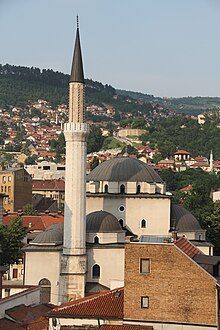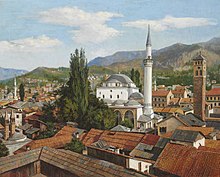Gazi Husrev-beg Mosque
| Gazi Husrev-beg Mosque | |
|---|---|
 Gazi Husrev-beg Mosque from Hotel Europe | |
| Religion | |
| Affiliation | Sunni Islam |
| Location | |
| Location | Sarajevo, Bosnia and Herzegovina |
| Geographic coordinates | 43°51′33″N 18°25′44.5″E / 43.85917°N 18.429028°E |
| Architecture | |
| Architect(s) | Acem Esir Ali "Alaüddin" |
| Type | Mosque |
| Style | Ottoman architecture |
| Completed | 1531 |
| Specifications | |
| Capacity | ~1,500 (including ~500 in courtyard) |
| Dome(s) | 9 |
| Dome height (outer) | 26 m |
| Dome dia. (outer) | 13 m |
| Minaret(s) | 1 |
| Minaret height | 47 m |
Gazi Husrev-beg Mosque (
History
The
Gazi Husrev-bey Mosque was the first mosque in the world to receive electricity and electric illumination in 1898 during the period of Austro-Hungarian Empire.[2]
Architecture

The mosque belongs to the type of complex-spaced, multi-domed mosques and it is a represent of the Early Period of
The exterior is dominated by the main dome, topped out only by a simple, yet monumental minaret. The entry side is marked with a portico resting on four wide columns and covered with little domes, only the central one, above the portal, being a bit greater than others, and resting on muqarnas-adorned pendentives, in contrast to others which are laid on simple, plain-surfaced pendentives. The monumental portal is richly decorated with muqarnas, as well as columns' capitals.
In his legacy, he stated: "Good deeds drive away evil, and one of the most worthy of good deeds is the act of charity, and the most worthy act of charity is one which lasts forever. Of all charitable deeds, the most beautiful is one that continually renews itself."[3]
Destruction and reconstruction

During the Siege of Sarajevo, Serbian forces purposely targeted many centers of the city's culture, such as museums, libraries, and mosques, and fired on them generally. As the largest and best known, the Beg's mosque was an obvious target.


Having suffered a significant amount of destruction, the reconstruction of the Mosque started with foreign - mainly Saudi - aid in 1996, right after the war. The old and faded layer of
Gallery
-
Mosque in 1900
-
The main entrancependentives above. There is also an ablaqdesign around the main entrance as well.
-
East side of the mosque
-
View from the market
-
The fountain in the sahn (courtyard) of the mosque
-
Gazi Husrev-beg Mosque's portico with 5 elegant islamic arches
See also
- Timeline of Islamic history
- Islamic architecture
- Islamic art
- List of mosques
- List of mosques in Bosnia and Herzegovina
References
- ^ "Nihad Čengić - Begova džamija kao djelo umjetnosti". Retrieved 17 July 2016.
- ^ Izvor: Dnevni avaz, br. 4297, godina XII, nedjelja, 9.9.2007., Panorama, str. 14
- ^ Visit Sarajevo. "Gazi Husrev Bey's Mosque". Archived from the original on 26 April 2010. Retrieved 12 May 2010.










